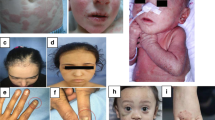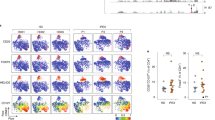Abstract
IPEX is a fatal disorder characterized by immune dysregulation, polyendocrinopathy, enteropathy and X-linked inheritance (MIM 304930). We present genetic evidence that different mutations of the human gene FOXP3, the ortholog of the gene mutated in scurfy mice (Foxp3), causes IPEX syndrome. Recent linkage analysis studies mapped the gene mutated in IPEX to an interval of 17–20-cM at Xp11.23–Xq13.3 (refs. 1,2).
Similar content being viewed by others
Main
The gene WAS, contained in this interval, was excluded as a candidate for IPEX (refs. 1,2). The scurfy syndrome in mice3 shares phenotypic features with IPEX and maps to a region of conserved synteny on the mouse X chromosome. Human and mouse FOXP3 were recently identified by positional cloning and the `scurfy' mutation was found to be a 2-bp insertion leading to a truncated Foxp3 protein product4.
As scurfy mice share many phenotypic features with IPEX, we investigated the possibility that mutations in FOXP3 might lead to IPEX. We examined three unrelated IPEX pedigrees for FOXP3 mutations by direct sequencing of genomic DNA. A G→A transition (nt 1,338), resulting in a putative Ala→Thr substitution at residue 384 (A384T), segregated with the disease in all members tested from family 1 (Fig. 1a; ref. 1). The two affected males tested (V-2 and V-7; Fig. 1a) were hemizygous for the mutation. Although the mutant residue threonine at 384 is chemically similar to serine (the most common amino acid found at this residue for human FOX proteins4), we hypothesize that the loss of the uniquely hydrophobic alanine residue of the scurfin protein causes IPEX in this family. We used a combination of standard and single-base sequence analyses of an additional 500 control X chromosomes and did not detect the A384T mutation, excluding the possibility that this mutation represents a polymorphism. In family 2 (Fig. 1b), we identified a CT dinucleotide deletion at 1481–1482 (delCT) within the FOXP3 termination codon, predicting a frameshift and the addition of 25 amino acids (Z432T; Table 1). We did not detect mutation of FOXP3 in family 3 (ref. 5). At this time, without additional studies, we cannot exclude the possibility of genetic heterogeneity within IPEX. These data, however, indicate that mutations of FOXP3 can result in a severe clinical phenotype (IPEX) in hemizygous human males.
Family 1 (a) is a five-generation pedigree1. Family 2 (b) is a three-generation pedigree of Japanese origin with one affected male. In both pedigrees, family members from which DNA was available for analysis are marked by an asterisk.
FOXP3 is one of multiple genes encoding winged helix/forkhead transcription factors6 (Fox proteins). Mutations affecting the forkhead motif of FOX proteins (missense, deletions and nonsense) have been associated with specific disease states. The rat thyroid transcription factor-2 (Ttf-2) and its human ortholog FKHL15 have been redesignated Foxe1 and FOXE1, respectively. Two siblings with thyroid agenesis, cleft palate and choanal atresia were found to be homozygous for a missense mutation (Ala65Val) within the forkhead domain of FOXE1. The mutant protein has impaired DNA binding and loss of transcriptional function7. Several mutations, including two independent microdeletions (10 and 11 bp) and several missense mutations within the forkhead domain of FOXC1 (originally called FKHL7), have been shown to cause juvenile glaucoma and anterior segment anomalies8,9 (Table 1). One three-generation family with Axenfeld–Rieger syndrome (ARS) is reported to harbor a FOXC1 nonsense mutation upstream of the forkhead DNA-binding domain, generating a truncated protein10. All disease-causing mutations of FOXC1 have resulted in autosomal dominant transmission. The mutant FOX proteins and the human scurfy/FOXP3 mutations identified in the IPEX pedigrees are outlined in Table 1.
Although little is known about the mechanism of action of the Foxp3 protein product, scurfin, the phenotype of scurfy mice suggests that it is a critical control switch for T-cell activation. We postulate that when scurfin is absent or inactive, or when target DNA-binding sites are modified, T cells proliferate and become activated in an uncontrolled fashion or fail to undergo apoptosis, resulting in early-onset autoimmune disease. This may explain the clinical benefit of immunosuppressive therapies such as cyclosporin A, FK506 and high-dose glucocorticoids in the management of patients with IPEX (ref. 2). Mouse scurfy T cells are hyperresponsive to TCR ligation and less sensitive than control T cells to inhibitors of tyrosine kinases (such as genistein) and cyclosporin A (ref. 11). These compounds block the signal transduction pathways involved in T-cell activation at distinct biochemical sites12, indicating that mutational inactivation of Foxp3 may affect T-cell function at a very fundamental level. Because scurfy mice and at least some patients with IPEX share a common genetic defect, the mice should provide a useful model to evaluate potential new approaches to the treatment of IPEX.
References
Ferguson, P.J. et al. Am. J. Med. Genet. 90, 390–397 (2000).
Bennett, C.L. et al. Am. J. Hum. Genet. 66, 461–468 (2000).
Lyon, M.F., Peters, J., Glenister, P.H., Ball, S. & Wright, E. Proc. Natl. Acad. Sci. USA 87, 2433–2437 (1990).
Brunkow, M.E. et al. Nature Genet. 27, 68–73 (2001).
Powell, B.R., Buist, N.R. & Stenzel, P. J. Pediatr. 100, 731–737 (1982).
Kaestner, K.H., Knochel, W. & Martinez, D.E. Genes Dev. 14, 142–146 (2000).
Clifton Bligh, R.J. et al. Nature Genet. 19, 399–401 (1998).
Mears, A.J. et al. Am. J. Hum. Genet. 63, 1316–1328 (1998).
Nishimura, D.Y. et al. Nature Genet. 19, 140–147 (1998).
Mirzayans, F. et al. Eur. J. Hum. Genet. 8, 71–74 (2000).
Clark, L.B. et al. J. Immunol. 162, 2546–2554 (1999).
Yorgin, P.D. et al. J. Immunol. 164, 2915–2923 (2000).
Acknowledgements
We thank the members of all three families for participation; I.P. Blair for advice and critical review of the manuscript; and M. McEuen for technical assistance. This work was supported by grants from the Jeffrey Modell Foundation, the Immunodeficiency Foundation, NIH grant HD17427 and the DiJoria Wiskott–Aldrich research fund.
Author information
Authors and Affiliations
Corresponding author
Rights and permissions
About this article
Cite this article
Bennett, C., Christie, J., Ramsdell, F. et al. The immune dysregulation, polyendocrinopathy, enteropathy, X-linked syndrome (IPEX) is caused by mutations of FOXP3. Nat Genet 27, 20–21 (2001). https://doi.org/10.1038/83713
Received:
Accepted:
Issue Date:
DOI: https://doi.org/10.1038/83713
This article is cited by
-
High-intensity intermittent training ameliorates methotrexate-induced acute lung injury
BMC Pulmonary Medicine (2024)
-
Loss of chromosome Y in regulatory T cells
BMC Genomics (2024)
-
A guide to thymic selection of T cells
Nature Reviews Immunology (2024)
-
Oleic acid availability impacts thymocyte preprogramming and subsequent peripheral Treg cell differentiation
Nature Immunology (2024)
-
Molecular Engineering of Interleukin-2 for Enhanced Therapeutic Activity in Autoimmune Diseases
BioDrugs (2024)



